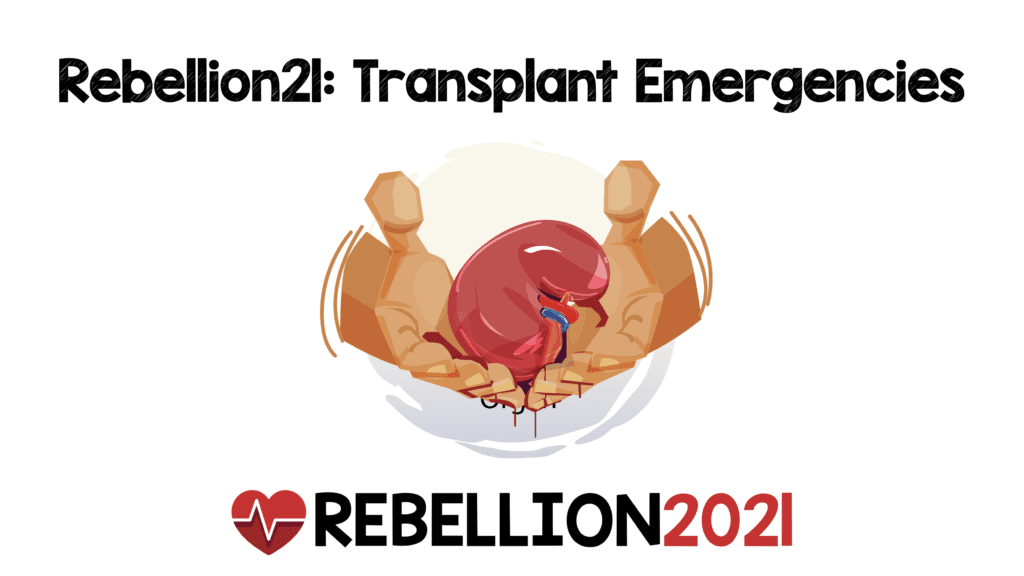
 In this 22-minute presentation from Rebellion in EM 2021, Dr. Chris Colbert, DO discusses transplant emergencies and how to manage them.
In this 22-minute presentation from Rebellion in EM 2021, Dr. Chris Colbert, DO discusses transplant emergencies and how to manage them.

Chris Colbert, DO
Assistant EM Residency Director
Assistant Professor of Clinical Emergency Medicine
UIC
Chicago, IL
Twitter: @DrChrisER
Objectives
- Identify physical exam findings unique to transplant populations that will facilitate an early diagnosis of acute pathology
- Review useful tricks of the trade with bedside ultrasound for the patient with recent organ transplant
- Discussed early clinical manifestations of a chewed and chronic graft-versus-host disease often overlooked
- Review specific nuances to the kidney and liver transplantation.
Transplant Emergencies
- Timing is Everything
- Early: Within 1 month of transplant
- Surgical site
- Nosocomial
- Graft source (? CMV, Epstein-Barr, and BK polyomavirus)
- Urinary tract infection
- Diff infection
- Superinfection of graft tissue
- Vascular access infection
- Intermediate: Within 1 to 6 months of transplant
- Opportunistic infections (due to immunosuppressive medications)
- Reactivation of dormant host infections (CMV, HSV, HZV, EBV)
- Late: Greater than 6 months of transplant
- Community acquired infections
- Chronic rejection
- Chronic viral infections
- Rejection
- Three phases of rejection:
- Hyperacute: Minutes
- Acute: Weeks to Months
- Chronic: Years
- Fever can be a sign of rejection, NOT always infection (Biopsy is typically needed)
- Kidney: Malaise, Fever, Skin Tenderness, Oliguria
- Liver: Fever, Peripheral Edema, Abdominal Pain, Generalized Weakness, Ascites
- Cardiac: Dysrhythmia, Palpitations, Fever, Shortness of Breath
- Medication
- Induction: Directly after transplant
- Maintenance: 3 months post-transplant
- Triple therapy: 3 to 12 months post-transplant
- Common med side effects:
- Cyclosporine: Nephrotoxic, Hyperkalemia, Hypomagnesemia, Gingival Hyperplasia, Hemolytic Uremic Syndrome
- Mycophenolate: Abdominal pain, Diarrhea, Nausea/Vomiting, Headache
- Tacrolimus: Paresthesia, Hair Loss, Headache/Seizures, Tremor
- Azathioprine: Hepatotoxicity, Pancreatitis, Abdominal Pain
- Corticosteroids: Weight Gain, Bruising, GI Bleeding, Cushing Appearance, Acne
- Graft Versus Host Disease (GVHD)
- Acute: Abdominal Pain, Diarrhea, Maculopapular Rash, Persistent Nausea, Lab Abnormalities (Elevated LFTs)
- Chronic: Scleroderma Rash, Dry Mouth, Dry Eyes, Blurred Vision, Thinning Hair, Fatigue, Low Grade Fever, Abdominal Discomfort
- Anatomy
- Don’t forget about other possibilities
- Fistula
- Hematoma
- Vein Thrombosis
- Pseudoaneurysm
- Arterial Stenosis
- For More on This Topic Checkout:
- Don’t forget about other possibilities
- Three phases of rejection:
- Early: Within 1 month of transplant
Post Peer Reviewed By: Salim R. Rezaie, MD (Twitter: @srrezaie)
The post Rebellion21: Transplant Emergencies and Their Management via Chris Colbert, DO appeared first on REBEL EM - Emergency Medicine Blog.
